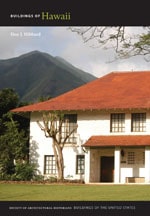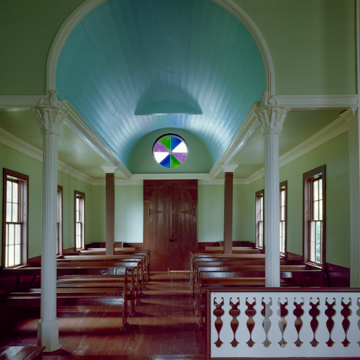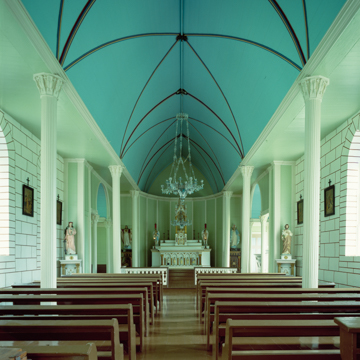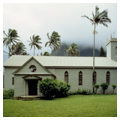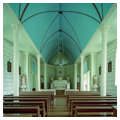This was Father Damien's church, the center of his efforts to bring compassionate care and a dignified life to patients exiled at Kalawao. The original St. Philomena church predated the arrival of Damien by a year, having been dedicated on May 30, 1872. The current Gothic Revival structure and its west wing are the result of several construction episodes. In winter 1876, three years after working at the settlement, Damien enlarged the simple rectangular St. Philomena by adding a west wing with a steeple. The original church became the new church's transepts, and the addition served as the nave until 1888–1889, when the current nave and chancel were added. For all intents and purposes, the original prefabricated structure of 1872 no longer exists, having been incorporated into the expansion of 1888–1889.
The expansion was a major undertaking, with most of the funding coming from charitable donations made outside Hawaii. The projecting crenellated tower and initial forty feet of the nave are of stone found within the settlement. The congregation quarried and hauled the stones, mixed the mortar, and did much of the carpentry work. Damien, who by this time was disfigured by leprosy, directed construction. He died on April 15, 1889, prior to completion of the church, and was buried in the churchyard. A black marble cross was placed above his grave by the Catholic mission. The “V.C.J.S.” on the stone refers to the motto of the Congregation of the Sacred Hearts of Jesus and Mary, “Vivat Cor Jesu Sacratissimum” (“Live Forever the Most Sacred Heart of Jesus”). On February 3, 1936, at the request of King Leopold III, Damien's body was exhumed and returned to his native Belgium. In 1995 his hand was returned to Kalaupapa and reinterred in his grave.
The church was restored in 1991, under the direction of Spencer-Mason Architects. The interior paint scheme follows the colors and patterning of 1889, with its block design lined in red.

